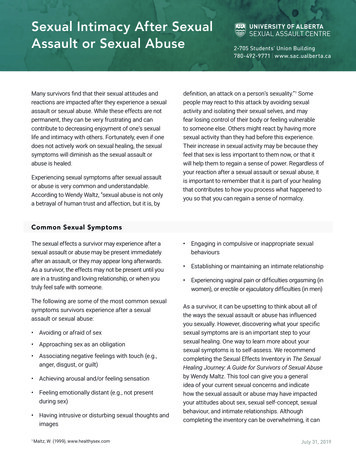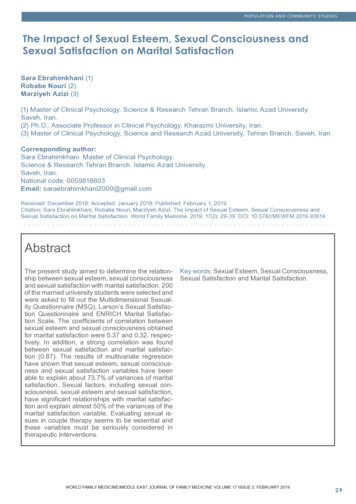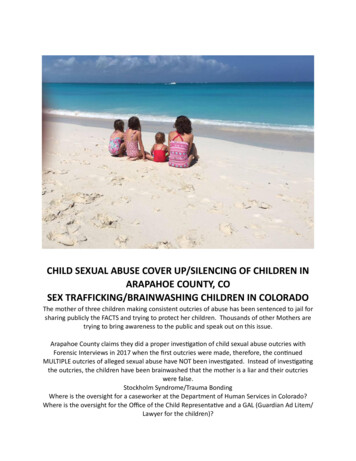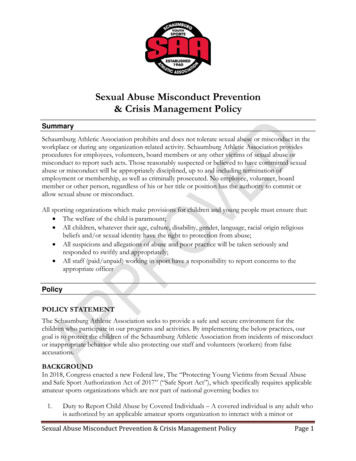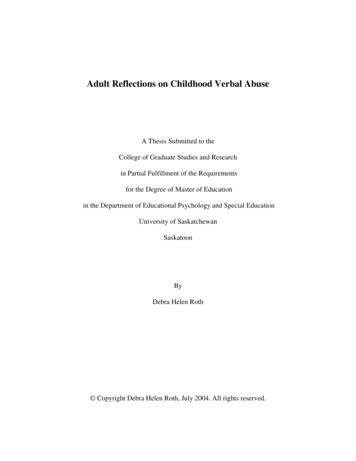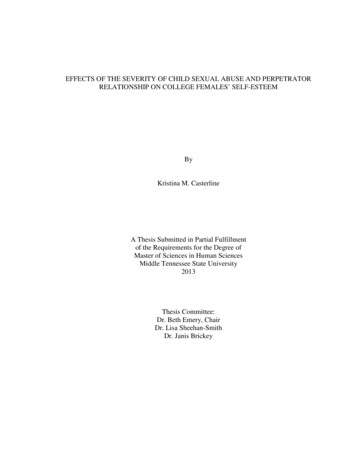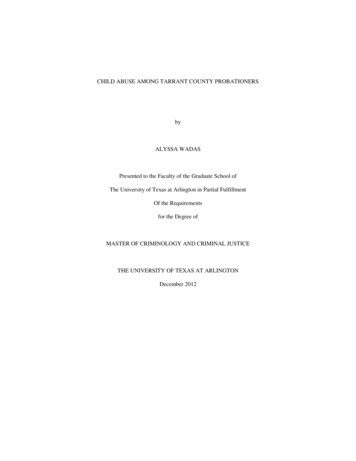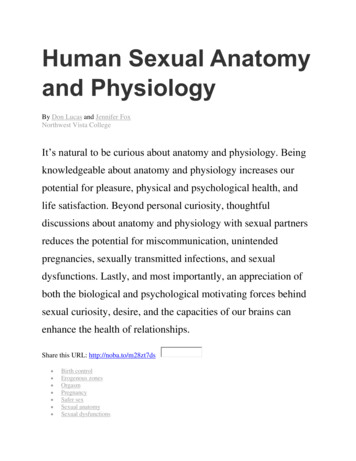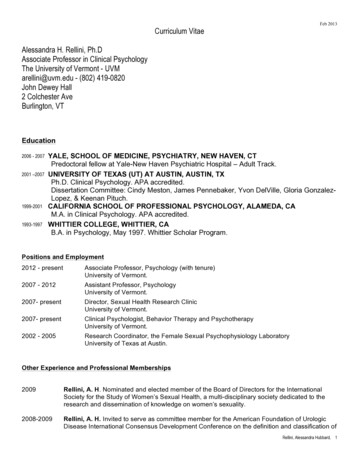
Transcription
The Impact of Sexual Abuse on Children:CSAAS and Other IssuesAnthony Urquiza, Ph.D.CAARE CenterUC Davis Medical Center10:15am-11:45amSaturday November 19, 20172016 CASA State ConferenceVirginia Department of Criminal JusticeServicesOverview and Objectives Acquire understanding of the impact of CSA ondeveloping concepts, relationship skills,characteristics necessary for a healthydevelopment. Understand the context and process of CSA andthe research literature children’s responses toabuse. Overview of related CSA issues (e.g., falseallegations, patterns in disclosure) Discussion and questionsA Contextual Approach to Child MaltreatmentThis is what child developmentis all about The power of 1000 little thingsover 1 or 2 big things“The strength of the relationship isa function of the consistencyand continuity of theinteraction”“Patterns of interaction over time”1
So what does this have to do with childmaltreatment?Child Sexual AbuseExample: A girl is repeatedly fondled and forced to engage inoral copulation from 3 – 8 years. The perpetrator, herstepfather, tells her that this is their ‘special secret’ and ifshe tells anyone – then her parents will divorce and she willhave to go live in foster care.‘Pattern of interactions over time’What happens with a young child who is raised in aneroticized environment:What they ‘learned’ What they didn’t ‘learn’ What happens with a young child who is raised in aneroticized environment:What they ‘learned’ What they didn’t ‘learn’ Sexual gratification Normal sexual development Distorted body image (self Age-appropriate peer(increased masturbation)view through sexualizedbody parts) Sexualized relationships(sexually inappropriatebehaviors) Distrust of closeinterpersonal relationships(people have sexualizedintent)relationships Self-perception based onachievements and abilities Trust in close interpersonalrelationshipsBTW: It’s not just the behaviors– its also the cognitions!2
The Context of Child Sexual AbuseAny questions?Time to change gears Child Sexual Abuse AccommodationSyndromeThe Child Sexual Abuse Accommodation Syndrome (CSAAS) iscomposed of five categories, of which two define basicchildhood vulnerability and three are sequentially contingenton the sexual assault:(1) Secrecy(2) Helplessness----------------------(3) Entrapment and Accommodation,(4) Delayed, Unconvincing Disclosure(5) RetractionChild Sexual Abuse AccommodationSyndrome“The accommodation syndrome is proposed as asimple and logical model for use by clinicians toimprove understanding and acceptance of thechild’s position in the complex and controversialdynamics of sexual victimization.”3
Child Sexual Abuse AccommodationSyndromeWhy use CSAAS in court?There are many entrenched myths, prejudices, and distortedopinions regarding sexually abused children’s actions,behaviors, and responses to their victimization.The jury may not appreciate/understand the child’s response totheir victimization.‘Preparing to rehabilitate a child witness’Child Sexual Abuse AccommodationSyndromeCommon Examples Child has a significant delay in disclosing abuse Child has opportunity to disclose abuse and does not Child is asked about being abused and denies Description of abusive experiences is inconsistent Child appears to voluntarily return to situation where abuseoccurs Perpetrator and victim appear to have positive relationship After disclosure, child states abuse never occurredA Side Note about the Context of CSA How would a person go about engaging achild in a sexual relationship?[Read Conte, Wolfe, & Smith on the concept of‘grooming’]4
A Side Note about the Context of CSA How would a person go about engaging achild in a sexual relationship? Gain accessEstablish a relationshipGain trustIntroduce sexualityIncrease the amount of sexualityOvertures of a ‘special relationship,’ threats/promisesnot to tell, other people wouldn’t understand, youwould get in trouble, I would get in trouble, etc.A Side Note about the Context of CSA How would a person go about engaging achild in a sexual relationship?Three studies of perpetrator strategies Conte, Wolf, and Smith (1989). What sexual offenders tell us aboutprevention strategies. Child Abuse and Neglect, 13, 293-301.Elliott, M., Browne, K, & Kilcoyne, J. (1995). Child sexual abuse prevention:What offenders tell us. Child Abuse and Neglect, 19-5, 579-594.Leclerc,B., Proulx, J., Beauregard, E. (2009). Examining the modusoperandi of sexual offenders against children and its practicalimplications. Aggression and Violence Behavior, 14, 5-12.A Side Note about the Context of CSA Was there something about their appearance thatattracted you? Mostly vivaciousness, friendliness, proximity, close to me.No physical characteristics. I felt they would be victimswillingly because they were being overly friendly with me. The look in their eyes. It’s a look of trust. They like you. Ifthey are going to show resistance, they’ll look away. Has a look of being vulnerable in some way. May not beassertive; may not be outgoing. Trusts adults. You can seethis in their body language, the way they look with their eyes.The way they hold themselves.5
A Side Note about the Context of CSA If there was more than one child with this physicalappearance, why did you select one over the other? I would choose the youngest one or the one whom I thoughtwould not talk about it. I would probably pick the one who appeared more needy, thechild hanging back from others or feeling picked on bybrothers or sisters. The one who liked to sit in my lap. Theone who likes attention and stroking.A Side Note about the Context of CSA Was there something about the child’s behavior thatattracted you to the child? Friendly, showed me their panties. The way the child would look at me, trustingly. The child whowas teasing me, smiling at me, asking me to do favors. Someone who had been a victim before; quiet, withdrawn,compliant. Someone who had not been a victim would bemore non-accepting of the sexual language or stepping overthe boundaries of modesty. Quieter, easier to manipulate, less likely to object or put up afight, goes along with things.6
A Side Note about the Context of CSA After you identified a potential victims, did you thingabout getting caught? In general, no. I selected victims that I thought wouldn’t report me. Yes, this would be a primary part of my strategy in picking the timeand place and victim. That’s why most of my victims were 7 andbelow. Some were even 3 years old, and I don’t think they knewwhat was going on. I went after the victims that had a low potentialfor telling someone. Yes, but I excused myself by telling myself that I wasn’t reallymolesting her. I was just being curious. Yes, it was a fear the entire time I was molesting her. Toward theend, it got to be a contest to see if I could get away with it.A Side Note about the Context of CSA Additional questions in Conte, Wolf, & Smith (1989) After you had identified a potential victim, what did you doto engage the child into sexual contact? After you identified a potential victim, what did you say toengage the child into sexual contact? How did you gain control over the victim? Did you threaten the victim? Write a manual on how to sexually abuse a child.Context of Child Sexual Abuse Most child molesters are male Most child molesters have a pre-existing relationshipwith the victim (family member/father, step-father, otherrelative, babysitter, neighbor, etc) The perpetrator usually holds a position of power (i.e.,size, authoritarian role) over the child Child molesters typically engage in a relationship withthe child (i.e., grooming), then use this relationship toget the child to meet their sexual needs, and avoidgetting caught7
Child Sexual Abuse AccommodationSyndromeOkay, Done with the side note - back to CSAAS SecrecyHelplessnessEntrapment and AccommodationDelayed and Unconvincing DisclosureRetractionChild Sexual Abuse AccommodationSyndromeSECRECYMyth: Children will tell about being abusedCoercive and manipulative strategies: ThreatsBribesSpecial ld Sexual Abuse AccommodationSyndrome“Don’t tell your mother”“I’ll kill you”“You’ll get in big trouble”“If you tell anyone, it will break up the family and you willend up in a foster home”“I’ll get in big trouble”“This is our special secret - no one else would understand.If you told then we would not be able to spend specialtime together”8
Child Sexual Abuse AccommodationSyndromeHELPLESSNESSMyth: Children should be able to protect themselves from beingabused Children younger, smaller, weaker Child cannot insure their own sexual safety Parental supervision may be impaired Perpetrator often holds an authoritarian role Parent/Caregiver ability to protect may be impaired (e.g., substance abuse, mental health problems, neglect) Parent/Caregiver is perpetratorChild Sexual Abuse AccommodationSyndromeENTRAPMENT/ACCOMMODATIONMyth: Children will avoid their perpetratorIt is not uncommon for a sexuallyabused child, who cannot preventtheir continued re-victimization(and they cannot disclose their abuse),to engage in faulty or maladaptivemeans of coping with their trauma.Child Sexual Abuse Accommodation SyndromeOne set of strategies involve attempting to use external meansto avoid/cope with their victimization:They may make futile attempts to deter their victimization. staying away from home (but you have to come home eventually)trying to lock bedroom/bathroom doorswearing two or three pairs of pajamas at nightfeigning sleep (during efforts to molest them)It is important to understand that these efforts aretypically unsuccessful in trying to insure the sexualsafety of the child victim.9
Child Sexual Abuse AccommodationSyndromeA second strategy used to cope with the victimizationis to remove oneself psychologically from thevictimization through the process of dissociation. Blanking out during the abuse Becoming numb and not feeling anything Staring out into space (e.g., staring through awindow, looking at something on the wall) Feeling disconnected from what was happening tothemChild Sexual Abuse AccommodationSyndromeThis pattern of dissociation/detachment may result inthe victim not displaying outward distress whentalking about the abuse.It may be important for the child to maintain an outward positivedemeanor“She didn’t look like she was abused to me”When testifying, children may talk about abuse events withoutdistress, leading jurors to incorrectly develop the notion thatmaybe they were not abused.In a study of children’s emotional responses during anevidentiary interview, 75% of CSA children expressed‘neutral’ emotion.Sayfan, Mitchell, Goodman, Eisen, & Qin (2008)Child Sexual Abuse AccommodationSyndromeDELAYED, UNCONVINCING DISCLOSUREMyth: Children will tell right away and disclose clearlyabout what happened to them.The myth: Children will immediately disclose their sexualvictimizationThere is usually a significant delay in disclosure from the initialonset of the abuse.See Briere and Elliot (1994) - approximately 75% of children failed todisclose 12 months after the onset of their sexual victimization (thisfinding is supported by other research).10
Child Sexual Abuse AccommodationSyndromeDELAYED, UNCONVINCING DISCLOSUREMyth: Children will tell right away and disclose clearlyabout what happened to them.It is difficult to do research on disclosure, but theresearch supports that one of the consistent findingsis Closer the relationship between the perpetrator and thevictim/the long it take the victim to discloseClose proximity: Perpetrator has more control, victim moreeasily frightened.Child Sexual Abuse AccommodationSyndromeDELAYED, UNCONVINCING DISCLOSUREEven when children do report abuse (which is later confirmed),their accounts are frequently marked by inconsistencies andtentativeness Disclosure is a process, not an act Dissociation and disclosureChild Sexual Abuse AccommodationSyndromeDELAYED, UNCONVINCING DISCLOSURESummit: Gradual disclosure, initial disclosure,following by additional information and disclosuresRecent: Rapid disclosure, victim tells about all or mostof what happened the first time they disclosedData to support both types of disclosure.11
Child Sexual Abuse AccommodationSyndromeRETRACTIONMyth: If the child victims retracts the allegation, they were lying inthe first place.Myth: All children lie about things, and they also lie about sexualabuse. The child has ambivalent feelings about the perpetrator The perpetrator has continued access to the child; theperpetrator continues to manipulate/coerce the child A proxy for the perpetrator has access to the child The child is fearful of testifying in courtChild Sexual Abuse AccommodationSyndromeRETRACTIONA Filial Dependency Model of Recantation(Malloy, Lyon, & Quas, 2007)N 257 substantiated cases from dependency court. 23.1% of casesinvolved recantation.Best predictor of retraction was pressure imposed by a familymember.Also, abuse victims more vulnerable to familial adult influences: younger children abused by a parent lacked caregiver support Malloy Lyon, & Quas (2007)Why do people not know about CSA? Sources of Information: Most people acquire information about CSAthrough TV, newspaper, sensationalized accounts. Finkelhor (1984): Study supported notion that the general publichave misperceptions of CSA. Gray (1993): Jurors involved in a CSA case where an expert testifiedwere better informed than members of a jury pool. Clinical Intervention: Sound clinical practice involves theassessment of parental distortions and misperceptions regardingCSA.12
And now for something completelydifferent What else can we talk about?False Allegations of Sexual AbuseChildren’s Sexual BehaviorFalse Allegations of Child SexualAbuse13
False Allegations of CSA But wait Don’t children lie about being sexually abused? Yes, children lie about being abused (i.e., false allegationshappen)Aren’t there studies that show that about half of children whomake allegations of CSA are lying? Yes, there are studies that report about half of allegationsare false.False Allegations of CSA These are the studies supporting frequent false allegations ofCSA Benedek and Schetky (1984)55.5% of allegationswere deemed falseGreen (1986)36.4% of allegationswere deemed falseFalse Allegations of CSA Author/DateSampleRatePeters (1979)646%Goodwin et al. (1979)462%Tufts’ (1984)1818%Jones & McGraw (1987)5761%Faller (1996)1423%Everson & Boat (1989)245%U.S. DHHS-ACYF (1999)? 1%Oates et al. (2000)5512.5%Trocme & Bala ------------------------------------------Benedek & Schetky (1984)1855.5%Green (1986)1136.4%14
False Allegations of CSA The best study:Trocme & Bala (2004)N 7984%In none of the 4% of cases was it the child who made theallegation that was determined to have been false.The worst studies:Benedek & Schetky (1984)Green (1986)N 18N 1155.5%36.4%Small sample of children referred to a private practice becauseof concerns the child was making a false allegation (Theseare NOT research studies)Children’s Sexual BehaviorAnother Slight Change in Topic Children’s Sexual BehaviorResearch of William Friedrich and the ChildSexual Behavior Inventory (CSBI)15
Another Slight Change in Topic Sample: Parent report of 467 children; age 3-6 years; screened/nonabusedBehaviorFrench KissingTries to look at people undressingShows genitals to adultsLooks at nude picturesShy about undressingAsks others to engage in sex actsImitates sexual behavior with dollsMasturbates with handMasturbates with an objectTouches genitals when in publicTouches breastsTouches other’s 33%16%8%34%0%4%17%1%19%46%6%Larsson, Svedin, & Friedrich (2000).If we have enough time The role of Shame in CSAThe role of Trust in CSAWhat happens in treatment?Questions and AnswersI would be glad to send you a copy of this powerpoint; also copies of allof the articles mentioned today.Finally, if you want CSA information – please email us!16
Whoa That’s the end!Thank you!Anthony Urquiza, Ph.D. 916-734-7608ajurquiza@ucdavis.edu17
child in a sexual relationship? Three studies of perpetrator strategies Conte, Wolf, and Smith (1989). What sexual offenders tell us about prevention strategies. Child Abuse and Neglect, 13, 293-301. Elliott, M., Browne, K, & Kilcoyne, J. (1995). Child sexual abuse prevention: What offenders tell us. Child Abuse and Neglect, 19-5, 579-594.
